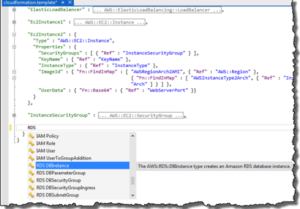Introduction to AWS CloudFormation
AWS CloudFormation is a powerful carrier that allows you to provision and manage AWS infrastructure as code (IaC). It permits you to define and install a set of AWS sources in a controlled and predictable manner. In this newsletter, we can delve into the info of AWS CloudFormation, exploring its definition, advantages, alternatives, key terms, and how to create and set up templates. Before we start, if you are interested learning about AWS, we would recommend you to join AWS Certification Training here.
What is AWS CloudFormation?
AWS CloudFormation is a declarative IaC provider that enables users to define and provision AWS infrastructure in a repeatable and green way. Using a template-primarily based method, CloudFormation lets in you to explain your preferred AWS assets and their configurations, automating the provisioning and updating process. This no longer best complements resource control but additionally promotes consistency and scalability for your cloud surroundings.
Benefits of AWS CloudFormation
Automation
AWS CloudFormation permits users to define and provision AWS infrastructure as code (IaC). This way rather than manually configuring and deploying resources, users can automate the entire manner. Automation not handiest reduces the hazard of human blunders; however, it also hurries up the deployment of assets, making the development and operations workflows more efficient.
Consistency
One of the key blessings of CloudFormation is the ability to ensure regular configurations across distinct environments. With a properly-defined template, you can deploy the precise equal infrastructure in improvement, checking out, and production environments. This consistency minimizes the hazard of configuration drift and ensures that the infrastructure behaves predictably throughout specific tiers of the application lifecycle.
Version Control
CloudFormation templates are essentially code, and they can be saved in version manipulate systems such as Git. This enables groups to tune modifications, collaborate more efficiently, and roll lower back to preceding versions if wished. Version manipulate for infrastructure is critical for preserving a clean history of adjustments, ensuring duty, and facilitating collaboration amongst crew members.
Efficiency
By automating the resource provisioning manner, CloudFormation substantially improves efficiency. Developers and operations groups can set up complicated infrastructures with a unmarried template, lowering the time and effort required for manual configuration. This lets in corporations to iterate and installation changes greater swiftly, fostering a extra agile and responsive improvement cycle.
Scalability
CloudFormation affords the flexibility to scale assets up or down as wanted. This is especially important in dynamic cloud environments wherein workloads can also vary. With CloudFormation, you could without problems adjust the range of times, the potential of databases, or other resources to healthy the changing needs of your software, ensuring best performance and price-effectiveness.
Alternatives to AWS CloudFormation
Terraform
Terraform is a popular open-source infrastructure as code tool that helps multi-cloud environments, including AWS. It uses a declarative configuration language and lets in users to outline and provision infrastructure throughout numerous cloud companies. Terraforms flexibility and multi-cloud help make it a sturdy alternative to CloudFormation, especially for corporations with a multi-cloud method.
AWS CDK (Cloud Development Kit)
AWS CDK allows developers to outline infastructure the usage of acquainted programming languages which include Python, TypeScript, and Java. It presents a higher-stage abstraction in comparison to CloudFormation templates, making it less difficult for builders to express infrastructure necessities the usage of code constructs. AWS CDK is properly-applicable for groups that select the usage of programming languages for infrastructure provisioning.
Ansible
Ansible is an open-source automation device that supports cloud provisioning. While not unique to AWS, Ansible playbooks may be used to outline and deploy AWS resources. Ansible’s strength lies in its simplicity and versatility, making it appropriate for both infrastructure provisioning and configuration management across various environments.
AWS CloudFormation Template Terms and Concepts
Template
A CloudFormation template is a JSON or YAML file that defines the AWS resources and their configurations. It serves because the blueprint for the infrastructure you want to create and manage.
Stack
A stack is a group of AWS sources constructed from a CloudFormation template. It represents a single, deployable unit of infrastructure. Stacks can be easily controlled, up to date, or deleted as an entire.
Parameter
Parameters are enter values provided at some point of the creation of a CloudFormation stack. They permit customers to customise the template without enhancing its underlying code. Parameters decorate the reusability and adaptability of CloudFormation templates for one-of-a-kind scenarios.
Resource
Resources are entities within a CloudFormation stack, representing AWS infrastructure additives like EC2 times, S3 buckets, or databases. Each aid is defined in the template, specifying its kind and configuration.
Output
Outputs in CloudFormation constitute values returned when the stack is created. These values may be useful for obtaining facts about the created resources, making it less complicated to combine with other services or proportion statistics among stacks.
How to Create an AWS CloudFormation Template?
- Define Resources- Specify the AWS assets you need within the CloudFormation template.
- Add Parameters and Outputs- Customize the template with input parameters and outline output values.
- Write Template Code- Use JSON or YAML syntax to shape your CloudFormation template.
How to Deploy an AWS CloudFormation Template?
- Upload Template- Upload the CloudFormation template to an S3 bucket or provide it without delay.
- Configure Stack- Input parameter values and configure stack options.
- Review and Confirm- Review the changes and verify the stack introduction.
- Monitor Stack Creation- Track the reputation of the stack advent system within the CloudFormation console.
Conclusion
AWS CloudFormation streamlines the provisioning and management of AWS infrastructure by using adopting an IaC method. With the ability to automate resource introduction, make certain consistency, and beautify scalability, CloudFormation is an essential tool for cloud architects and DevOps professionals. While knowledge its benefits and ideas are vital, exploring options and gaining hands-on revel in in developing and deploying CloudFormation templates will empower you to efficaciously manipulate your AWS assets. Embrace the power of infrastructure as code and elevate your cloud management skills with AWS CloudFormation.








